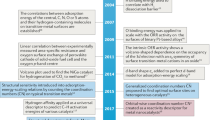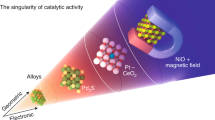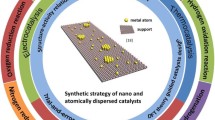Abstract
Heterogeneous catalysis is of great importance both industrially and academically. Rational design of heterogeneous catalysts is highly desirable, and the computational screening and design method is one of the most promising approaches for rational design of heterogeneous catalysts. Herein, we review some attempts towards the rational catalyst design using density functional theory from our group. Some general relationships and theories on the activity and selectivity are covered, such as the Brønsted–Evans–Polanyi relation, volcano curves/surfaces, chemical potentials, optimal adsorption energy window and energy descriptor of selectivity. Furthermore, the relations of these relationships and theories to the rational design are discussed, and some examples of computational screening and design method are given.










Similar content being viewed by others
References
National Research Council (U.S.). Panel on New Directions in Catalytic Science and Technology., Bell AT, National Research Council (U.S.). Board on Chemical Sciences and Technology (1992) Catalysis looks to the future. National Academy Press, Washington, DC
Ertl G (2008) Handbook of heterogeneous catalysis. 2nd completely rev. and enl. edn. Wiley-VCH; John Wiley, Weinheim, Chichester
Honkala K, Hellman A, Remediakis IN, Logadottir A, Carlsson A, Dahl S, Christensen CH, Norskov JK (2005) Ammonia synthesis from first-principles calculations. Science 307(5709):555–558
Logadottir A, Norskov JK (2003) Ammonia synthesis over a Ru(0001) surface studied by density functional calculations. J Catal 220(2):273–279
Jacobsen CJH, Dahl S, Clausen BS, Bahn S, Logadottir A, Norskov JK (2001) Catalyst design by interpolation in the periodic table: bimetallic ammonia synthesis catalysts. J Am Chem Soc 123(34):8404–8405
Zhang CJ, Lynch M, Hu P (2002) A density functional theory study of stepwise addition reactions in ammonia synthesis on Ru(0001). Surf Sci 496(3):221–230
Liu T, Temprano I, Jenkins SJ, King DA, Driver SM (2013) Low temperature synthesis of NH3 from atomic N and H at the surfaces of FeS2{100} crystals. J Phys Chem C 117(21):10990–10998
Iyngaran P, Madden DC, Jenkins SJ, King DA (2011) Hydrogenation of N over Fe{111}. Proc Natl Acad Sci USA 108(3):925–930
Gong XQ, Raval R, Hu P (2004) General insight into CO oxidation: a density functional theory study of the reaction mechanism on platinum oxides. Phys Rev Lett 93(10):106104
Gong XQ, Liu ZP, Raval R, Hu P (2004) A systematic study of CO oxidation on metals and metal oxides: density functional theory calculations. J Am Chem Soc 126(1):8–9
Liu Z-P, Gong X-Q, Kohanoff J, Sanchez C, Hu P (2003) Catalytic role of metal oxides in gold-based catalysts: a first principles study of CO oxidation on TiO2 supported Au. Phys Rev Lett 91(26):266102
Zhang CJ, Hu P (2001) CO oxidation on Pd(100) and Pd(111): a comparative study of reaction pathways and reactivity at low and medium coverages. J Am Chem Soc 123(6):1166–1172
Falsig H, Hvolbaek B, Kristensen IS, Jiang T, Bligaard T, Christensen CH, Norskov JK (2008) Trends in the catalytic CO oxidation activity of nanoparticles. Angew Chem Int Ed 47(26):4835–4839
Hoyle RB, Anghel AT, Proctor MRE, King DA (2007) Pattern formation during the oxidation of CO on Pt{100}: a mesoscopic model. Phys Rev Lett 98(22):226102
Walker AV, Klotzer B, King DA (1998) Dynamics and kinetics of oxygen dissociative adsorption on Pt{110}(1x2). J Chem Phys 109(16):6879–6888
Gruyters M, Ali T, King DA (1996) Theoretical inquiry into the microscopic origins of the oscillatory CO oxidation reaction on Pt{100}. J Phys Chem 100(34):14417–14423
Gruyters M, Ali T, King DA (1995) Modeling temporal kinetic oscillations for co oxidation on Pt(100)—the (1x1)-Co Island growth-rate power-law model. Chem Phys Lett 232(1–2):1–6
Goguet A, Burch R, Chen Y, Hardacre C, Hu P, Joyner RW, Meunier FC, Mun BS, Thompsett A, Tibiletti D (2007) Deactivation mechanism of a Au/CeZrO4 catalyst during a low-temperature water gas shift reaction. J Phys Chem C 111(45):16927–16933
Tibiletti D, Amieiro-Fonseca A, Burch R, Chen Y, Fisher JM, Goguet A, Hardacre C, Hu P, Thompsett A (2005) DFT and in situ EXAFS investigation of gold/ceria-zirconia low-temperature water gas shift catalysts: identification of the nature of the active form of gold. J Phys Chem B 109(47):22553–22559
Ovesen CV, Stoltze P, Norskov JK, Campbell CT (1992) A kinetic-model of the water gas shift reaction. J Catal 134(2):445–468
Madon RJ, Braden D, Kandoi S, Nagel P, Mavrikakis M, Dumesic JA (2011) Microkinetic analysis and mechanism of the water gas shift reaction over copper catalysts. J Catal 281(1):1–11
Wang Z, Cao XM, Zhu J, Hu P (2014) Activity and coke formation of nickel and nickel carbide in dry reforming: a deactivation scheme from density functional theory. J Catal 311:469–480
Zhang J, Zhong Z, Cao XM, Hu P, Sullivan MB, Chen L (2013) Ethanol steam reforming on Rh catalysts: theoretical and experimental understanding. ACS Catal 4(2):448–456
Jones G, Jakobsen JG, Shim SS, Kleis J, Andersson MP, Rossmeisl J, Abild-Pedersen F, Bligaard T, Helveg S, Hinnemann B, Rostrup-Nielsen JR, Chorkendorff I, Sehested J, Norskov JK (2008) First principles calculations and experimental insight into methane steam reforming over transition metal catalysts. J Catal 259(1):147–160
Manyar HG, Yang B, Daly H, Moor H, McMonagle S, Tao Y, Yadav GD, Goguet A, Hu P, Hardacre C (2013) Selective hydrogenation of alpha, beta-unsaturated aldehydes and ketones using novel manganese oxide and platinum supported on manganese oxide octahedral molecular sieves as catalysts. Chemcatchem 5(2):506–512
Yang B, Burch R, Hardacre C, Headdock G, Hu P (2012) Origin of the Increase of activity and selectivity of nickel doped by Au, Ag, and Cu for acetylene hydrogenation. ACS Catal 2(6):1027–1032
Cheng J, Hu P, Ellis P, French S, Kelly G, Lok CM (2009) An energy descriptor to quantify methane selectivity in Fischer-Tropsch synthesis: a density functional theory study. J Phys Chem C 113(20):8858–8863
Yamagishi S, Jenkins SJ, King DA (2008) Benzene and its dissociation products on Ir{100}. J Phys Chem C 112(37):14417–14427
Gong XQ, Raval R, Hu P (2005) CHx hydrogenation on Co(0001): a density functional theory study. J Chem Phys 122(2):024711
Burch R, Daniells ST, Hu P (2002) N2O and NO2 formation on Pt(111): a density functional theory study. J Chem Phys 117(6):2902–2908
Zhang CJ, Hu P (2001) A first principles study of methanol decomposition on Pd(111): mechanisms for O-H bond scission and C-O bond scission. J Chem Phys 115(15):7182–7186
Sheng T, Lin WF, Hardacre C, Hu P (2014) Significance of beta-dehydrogenation in ethanol electro-oxidation on platinum doped with Ru, Rh, Pd, Os and Ir. Phys Chem Chem Phys 16(26):13248–13254
Yang B, Burch R, Hardacre C, Headdock G, Hu P (2013) Influence of surface structures, subsurface carbon and hydrogen, and surface alloying on the activity and selectivity of acetylene hydrogenation on Pd surfaces: a density functional theory study. J Catal 305:264–276
Studt F, Abild-Pedersen F, Bligaard T, Sorensen RZ, Christensen CH, Norskov JK (2008) Identification of non-precious metal alloy catalysts for selective hydrogenation of acetylene. Science 320(5881):1320–1322
Wang H-F, Kavanagh R, Guo Y-L, Guo Y, Lu G-Z, Hu P (2012) Structural origin: water deactivates metal oxides to CO oxidation and promotes low-temperature CO oxidation with metals. Angew Chem Int Ed 51(27):6657–6661
Wang H-F, Kavanagh R, Guo Y-L, Guo Y, Lu G, Hu P (2012) Origin of extraordinarily high catalytic activity of Co3O4 and its morphological chemistry for CO oxidation at low temperature. J Catal 296:110–119
Medford AJ, Sehested J, Rossmeisl J, Chorkendorff I, Studt F, Norskov JK, Moses PG (2014) Thermochemistry and micro-kinetic analysis of methanol synthesis on ZnO (0001). J Catal 309:397–407
Wang Z, Liu X, Rooney DW, Hu P (2015) Elucidating the mechanism and active site of the cyclohexanol dehydrogenation on copper-based catalysts: A density functional theory study. Surf Sci. doi:10.1016/j.susc.2015.01.004
Vojvodic A (2012) Steam reforming on transition-metal carbides from density-functional theory. Catal Lett 142(6):728–735
Medford AJ, Vojvodic A, Studt F, Abild-Pedersen F, Norskov JK (2012) Elementary steps of syngas reactions on Mo2C(001): adsorption thermochemistry and bond dissociation. J Catal 290:108–117
Wang ZY, Cao XM, Zhu JH, Hu P (2014) Activity and coke formation of nickel and nickel carbide in dry reforming: a deactivation scheme from density functional theory. J Catal 311:469–480
Cheng J, Hu P, Ellis P, French S, Kelly G, Lok CM (2010) Density functional theory study of iron and cobalt carbides for Fischer-Tropsch synthesis. J Phys Chem C 114(2):1085–1093
Wang Z, Yang B, Wang Y, Zhao Y, Cao XM, Hu P (2013) Identifying the trend of reactivity for sp2 materials: an electron delocalization model from first principles calculations. Phys Chem Chem Phys 15(24):9498–9502
Zhang J, Liu X, Blume R, Zhang A, Schlögl R, Su DS (2008) Surface-modified carbon nanotubes catalyze oxidative dehydrogenation of n-butane. Science 322(5898):73–77
Frank B, Blume R, Rinaldi A, Trunschke A, Schlögl R (2011) Oxygen insertion catalysis by sp2 carbon. Angew Chem Int Ed 50(43):10226–10230
Mavrikakis M (2006) Computational methods: a search engine for catalysts. Nat Mater 5(11):847–848
Senkan S (2001) Combinatorial heterogeneous catalysis—a new path in an old field. Angew Chem Int Ed 40(2):312–329
Senkan SM (1998) High-throughput screening of solid-state catalyst libraries. Nature 394(6691):350–353
Duan S, Senkan S (2005) Catalytic conversion of ethanol to hydrogen using combinatorial methods. Ind Eng Chem Res 44(16):6381–6386
Krantz K, Senkan S (2004) Systematic evaluation of monometallic catalytic materials for lean-burn NOx reduction using combinatorial methods. Catal Today 98(3):413–421
Ozturk S, Senkan S (2002) Discovery of new fuel-lean NO reduction catalyst leads using combinatorial methodologies. Appl Catal B 38(3):243–248
Medford AJ, Wellendorff J, Vojvodic A, Studt F, Abild-Pedersen F, Jacobsen KW, Bligaard T, Norskov JK (2014) Assessing the reliability of calculated catalytic ammonia synthesis rates. Science 345(6193):197–200
Nozières P, Pines D (1958) Correlation energy of a free electron gas. Phys Rev 111(2):442–454
Schimka L, Harl J, Stroppa A, Grüneis A, Marsman M, Mittendorfer F, Kresse G (2010) Accurate surface and adsorption energies from many-body perturbation theory. Nat Mater 9(9):741–744
Norskov JK, Abild-Pedersen F, Studt F, Bligaard T (2011) Density functional theory in surface chemistry and catalysis. Proc Natl Acad Sci USA 108(3):937–943
Santen RAv, Neurock M, Shetty SG (2009) Reactivity theory of transition-metal surfaces: a Brønsted–Evans–Polanyi linear activation energy—free-energy analysis. Chem Rev 110(4):2005–2048
Pallassana V, Neurock M (2000) Electronic factors governing ethylene hydrogenation and dehydrogenation activity of pseudomorphic PdML/Re(0001), PdML/Ru(0001), Pd(111), and PdML/Au(111) Surfaces. J Catal 191(2):301–317
Liu ZP, Hu P (2001) General trends in CO dissociation on transition metal surfaces. J Chem Phys 114(19):8244–8247
Logadottir A, Rod TH, Norskov JK, Hammer B, Dahl S, Jacobsen CJH (2001) The Bronsted-Evans-Polanyi relation and the volcano plot for ammonia synthesis over transition metal catalysts. J Catal 197(2):229–231
Greeley J, Jaramillo TF, Bonde J, Chorkendorff IB, Norskov JK (2006) Computational high-throughput screening of electrocatalytic materials for hydrogen evolution. Nat Mater 5(11):909–913
Greeley J, Norskov JK (2009) Combinatorial density functional theory-based screening of surface alloys for the oxygen reduction reaction. J Phys Chem C 113(12):4932–4939
Christensen CH, Norskov JK (2008) A molecular view of heterogeneous catalysis. J Chem Phys 128(18):182503
Norskov JK, Bligaard T, Rossmeisl J, Christensen CH (2009) Towards the computational design of solid catalysts. Nat Chem 1(1):37–46
Sabatier P (1911) Hydrogénations et déshydrogénations par catalyse. Ber Dtsch Chem Ges 44(3):1984–2001
Cheng J, Hu P, Ellis P, French S, Kelly G, Lok CM (2008) Bronsted-Evans-Polanyi relation of multistep reactions and volcano curve in heterogeneous catalysis. J Phys Chem C 112(5):1308–1311
Cheng J, Hu P (2008) Utilization of the three-dimensional volcano surface to understand the chemistry of multiphase systems in heterogeneous catalysis. J Am Chem Soc 130(33):10868–10869
Bligaard T, Norskov JK, Dahl S, Matthiesen J, Christensen CH, Sehested J (2004) The Bronsted-Evans-Polanyi relation and the volcano curve in heterogeneous catalysis. J Catal 224(1):206–217
Norskov JK, Bligaard T, Logadottir A, Bahn S, Hansen LB, Bollinger M, Bengaard H, Hammer B, Sljivancanin Z, Mavrikakis M, Xu Y, Dahl S, Jacobsen CJH (2002) Universality in heterogeneous catalysis. J Catal 209(2):275–278
Cheng J, Hu P (2011) Theory of the kinetics of chemical potentials in heterogeneous catalysis. Angew Chem Int Ed 50(33):7650–7654
Cheng J, Hu P, Ellis P, French S, Kelly G, Lok CM (2010) Some understanding of Fischer-Tropsch synthesis from density functional theory calculations. Top Catal 53(5–6):326–337
Cheng J, Gong XQ, Hu P, Lok CM, Ellis P, French S (2008) A quantitative determination of reaction mechanisms from density functional theory calculations: Fischer-Tropsch synthesis on flat and stepped cobalt surfaces. J Catal 254(2):285–295
Hou Y, Wang D, Yang XH, Fang WQ, Zhang B, Wang HF, Lu GZ, Hu P, Zhao HJ, Yang HG (2013) Rational screening low-cost counter electrodes for dye-sensitized solar cells. Nat Commun 4:1583
Hauch A, Georg A (2001) Diffusion in the electrolyte and charge-transfer reaction at the platinum electrode in dye-sensitized solar cells. Electrochim Acta 46(22):3457–3466
Burch R, Paun C, Cao XM, Crawford P, Goodrich P, Hardacre C, Hu P, McLaughlin L, Sa J, Thompson JM (2011) Catalytic hydrogenation of tertiary amides at low temperatures and pressures using bimetallic Pt/Re-based catalysts. J Catal 283(1):89–97
Author information
Authors and Affiliations
Corresponding author
Rights and permissions
About this article
Cite this article
Wang, Z., Hu, P. Some Attempts in the Rational Design of Heterogeneous Catalysts Using Density Functional Theory Calculations. Top Catal 58, 633–643 (2015). https://doi.org/10.1007/s11244-015-0406-9
Published:
Issue Date:
DOI: https://doi.org/10.1007/s11244-015-0406-9




